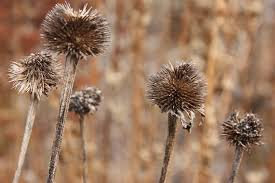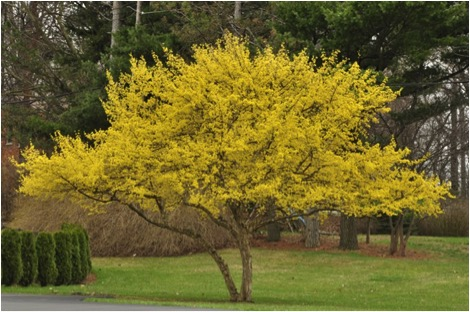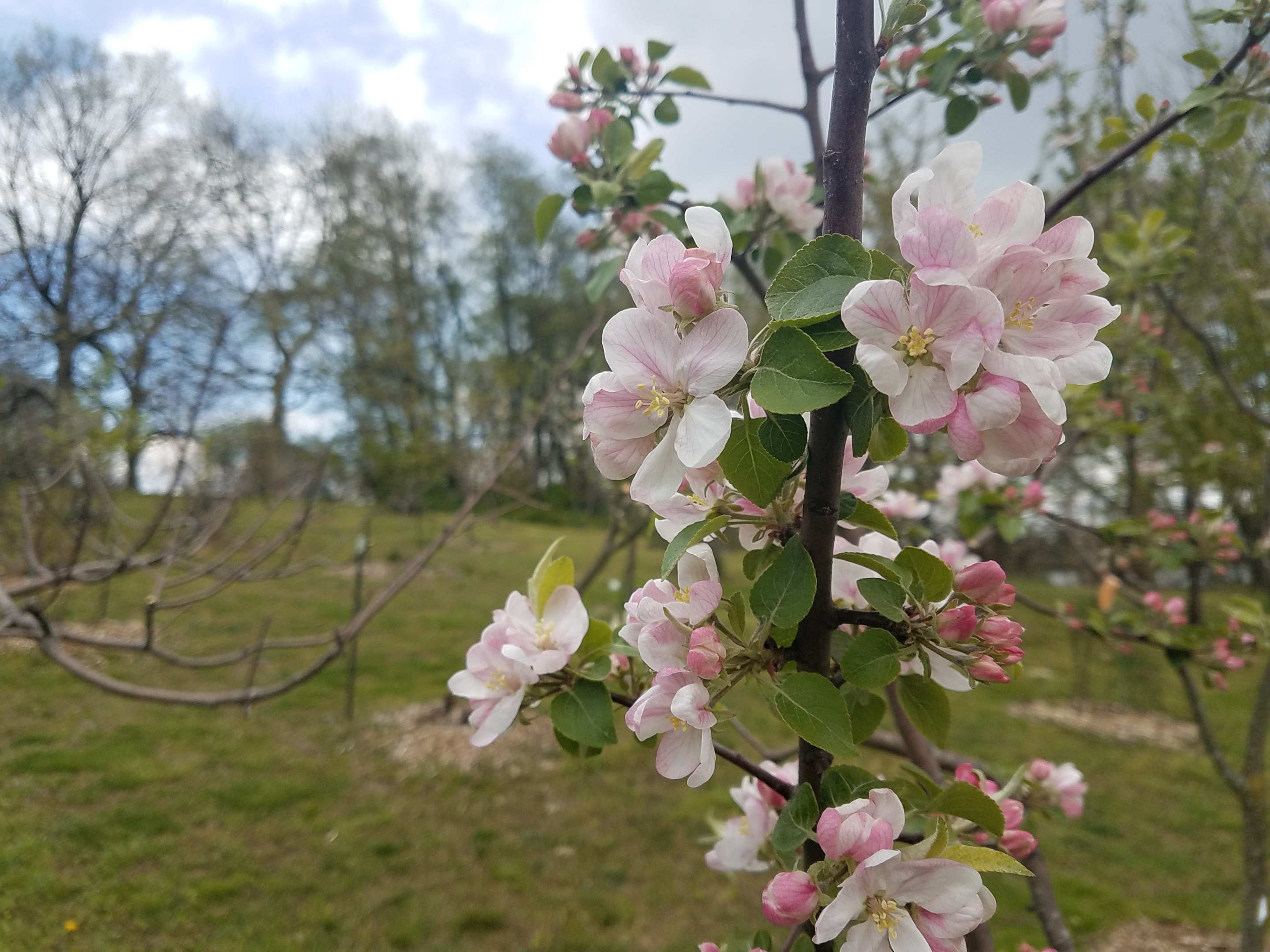POP TIPS: March Orchard Care
Phil Forsyth
Join in a virtual POPCORE training session
POPCORE 2: Orchard Pest & Disease Management
March 8, 6:30-8
POPCORE 3: Orchard Harvest & Use
March 15, 6:30-8
POPCORE 4: Orchard & Food Forest Design
March 22, 6:30-8
Finish winter pruning
Winter pruning season is almost over! We generally aim to complete all pruning by mid March, before plants break dormancy. Here's the link to POP's new pruning video series if you missed out on our hands-on workshops:
https://www.youtube.com/playlist?list=PLlZJgAop2db036xFPgbg4OTrKLndo3xiO
POP's fruit tree pruning guide:
https://www.phillyorchards.org/2016/01/21/pop-pruning-guide-fruit-trees/
POP's guide for berries and vines:
https://www.phillyorchards.org/2016/03/08/pruning-bushes-brambles-and-vines/
Cut back dead herbaceous material

Pest and Disease Monitoring & Identification
While most pests and diseases are still dormant in early March, it is a critical time for application of some key holistic and organic sprays and other management strategies. By late March, as orchard plants break dormancy, disease spores begin to spread. Some of the key management tasks to consider at this time:
Apply dormant oil sprays. Early March is good timing to spray oil for control of aphids, scale, red mites, spidermites, pear psylla, white flies and other soft bodied insects. Dormant oils should be applied to the trees before bud break in late winter or early spring. More info:
https://www.phillyorchards.org/2015/03/31/dormanthorticultural-oil-sprays/

Apply compost tea. In late winter to early spring, apply as a soil soak to boost soil life and fertility to boost tree health and resilience. More info on compost tea applications:
https://www.phillyorchards.org/2015/04/27/compost-tea-sprays-for-orchards/
If you don't have the capacity to brew compost tea, products including Effective Microbes can also serve this purpose (stay tuned for a new POP blog post in the works!).
Apply copper/sulfur fungicides. We generally recommend this only as a last resort for plants that have suffered severe crop loss from fungal diseases (like brown rot, black rot, mildew, etc) the previous year. Apply just before or after bloom. More info on sulfur and copper sprays:
https://www.phillyorchards.org/2016/03/14/organic-sulfur-spray-and-early-spring-management/
Biofungicides like Regalia and Serenade may also be applied during this period for improved disease control.
Cultivate soil under your fruit trees. For control of insects that overwinter in the ground, including oriental fruit moth, codling moth, plum curculio, tree borers, etc. Use a hoe or other implement to cultivate the top few inches of soil in late winter or early spring under the canopy of your trees. An even more effective option is to run chicken or poultry through your orchard space:
https://www.phillyorchards.org/2015/10/06/poultry-in-orchards/
Uwrap Your Figs and Pomegranates
By mid March, it is generally safe to unwrap your figs, pomegranates, and other tender plants from their winter protection. Join us for our Figs for Philly workshop on March 26 to learn more about growing and propagating figs in our cold climate!

Phil Forsyth
Join in a virtual POPCORE training session
POPCORE 3: Eco-Orchard Harvest & Use
March 15, 6:30-8
POPCORE 4: Orchard & Food Forest Design and Implementation
March 29, 6:30-8
Finish winter pruning
Winter pruning season is almost over! We generally aim to complete all pruning by mid March, before plants break dormancy. We have one last workshop this weekend:
Sat 3/4 Juntos Podamos! (pruning workshop for Spanish speakers only, please register in advance)
Here's the link to POP's pruning video series if you missed out on our hands-on workshops:
https://www.youtube.com/playlist?list=PLlZJgAop2db036xFPgbg4OTrKLndo3xiO
POP's fruit tree pruning guide:
https://www.phillyorchards.org/2016/01/21/pop-pruning-guide-fruit-trees/
POP's guide for berries and vines:
https://www.phillyorchards.org/2016/03/08/pruning-bushes-brambles-and-vines/
Cut back dead herbaceous material

Pest and Disease Monitoring & Identification
While most pests and diseases are still dormant in early March, it is a critical time for application of some key holistic and organic sprays and other management strategies. By late March, as orchard plants break dormancy, disease spores begin to spread. Some of the key management tasks to consider at this time:
Apply dormant oil sprays. Early March is good timing to spray oil for control of aphids, scale, red mites, spidermites, pear psylla, white flies and other soft bodied insects. Dormant oils should be applied to the trees before bud break in late winter or early spring. More info:
https://www.phillyorchards.org/2015/03/31/dormanthorticultural-oil-sprays/

Apply holistic sprays like compost tea or effective microbes. In late winter to early spring, apply as a soil soak to boost soil life and fertility to boost tree health and resilience.
More info on compost tea applications:
https://www.phillyorchards.org/2015/04/27/compost-tea-sprays-for-orchards/
If you don't have the capacity to brew compost tea, products including Effective Microbes can also serve this purpose:
https://www.phillyorchards.org/2022/04/04/em-for-orchards-are-effective-microorganisms-effective/
The above link also includes a full recipe for Michael Phillips' holistic sprays!
Apply fungicides. We generally recommend copper/sulfur fungicides only as a last resort for plants that have suffered severe crop loss from fungal diseases (like brown rot, black rot, mildew, etc) the previous year. Apply just before or after bloom. More info on sulfur and copper sprays:
https://www.phillyorchards.org/2016/03/14/organic-sulfur-spray-and-early-spring-management/
Biofungicides are a less harsh solution. Read more about options like Regalia and Serenade for improved disease control:
https://www.phillyorchards.org/2022/04/04/em-for-orchards-are-effective-microorganisms-effective/
Cultivate soil under your fruit trees. For control of insects that overwinter in the ground, including oriental fruit moth, codling moth, plum curculio, tree borers, etc. Use a hoe or other implement to cultivate the top few inches of soil in late winter or early spring under the canopy of your trees. An even more effective option is to run chicken or poultry through your orchard space:
https://www.phillyorchards.org/2015/10/06/poultry-in-orchards/
Uwrap Your Figs and Pomegranates
By mid March, it is generally safe to unwrap your figs, pomegranates, and other tender plants from their winter protection. Join us for our Figs for Philly workshop on March 25 to learn more about growing and propagating figs in our cold climate!

Phil Forsyth
Finish winter pruning
Winter pruning season is almost over! We generally aim to complete all pruning by mid March, before plants break dormancy. Check out our POP video series on pruning, read over POP's newly updated pruning guide (in English and Spanish). Or join us to do some hands-on fig pruning and propagation at our upcoming workshop:
Also note that PHS's McLean Tool Library has re-opened for the season and has various pruning equipment, including an orchard ladder, polesaws, loppers, etc.
Cut back dead herbaceous material

Pest and Disease Monitoring & Identification
While most pests and diseases are still dormant in early March, it is a critical time for application of some key holistic and organic sprays and other management strategies. By late March, as orchard plants break dormancy, disease spores begin to spread. Some of the key management tasks to consider at this time:
Apply dormant oil sprays. Early March is good timing to spray oil for control of aphids, scale, red mites, spidermites, pear psylla, white flies and other soft bodied insects. Dormant oils should be applied to the trees before bud break in late winter or early spring. More info:
https://www.phillyorchards.org/2015/03/31/dormanthorticultural-oil-sprays/

Apply holistic sprays like compost tea or effective microbes. In late winter to early spring, apply as a soil soak to boost soil life and fertility to boost tree health and resilience.
More info on compost tea applications:
https://www.phillyorchards.org/2015/04/27/compost-tea-sprays-for-orchards/
If you don't have the capacity to brew compost tea, products including Effective Microbes can also serve this purpose:
https://www.phillyorchards.org/2022/04/04/em-for-orchards-are-effective-microorganisms-effective/
The above link also includes a full recipe for Michael Phillips' holistic sprays!
Apply fungicides. We generally recommend copper/sulfur fungicides only as a last resort for plants that have suffered severe crop loss from fungal diseases (like brown rot, black rot, mildew, etc) the previous year. Apply just before or after bloom. More info on sulfur and copper sprays:
https://www.phillyorchards.org/2016/03/14/organic-sulfur-spray-and-early-spring-management/
Biofungicides are a less harsh solution. Read more about options like Regalia and Serenade for improved disease control:
https://www.phillyorchards.org/2022/04/04/em-for-orchards-are-effective-microorganisms-effective/
Cultivate soil under your fruit trees. For control of insects that overwinter in the ground, including oriental fruit moth, codling moth, plum curculio, tree borers, etc. Use a hoe or other implement to cultivate the top few inches of soil in late winter or early spring under the canopy of your trees. An even more effective option is to run chicken or poultry through your orchard space:
https://www.phillyorchards.org/2015/10/06/poultry-in-orchards/
Uwrap Your Figs and Pomegranates
By mid March, it is generally safe to unwrap your figs, pomegranates, and other tender plants from their winter protection. Join us for our Figs for Philly workshop on March 16 to learn more about growing and propagating figs in our cold climate!

Phil Forsyth
Finish winter pruning
Winter pruning season is almost over! We generally aim to complete all pruning by mid March, before plants break dormancy. Check out our POP video series on pruning, read over POP's newly updated pruning guide (in English and Spanish).
Also note that PHS's McLean Tool Library has re-opened for the season and has various pruning equipment, including an orchard ladder, polesaws, loppers, etc.
Cut back dead herbaceous material

Pest and Disease Monitoring & Identification
Check out POP's video series on pest & disease management, as well as our website resources for action plans for the most common pests and diseases we encounter in Philadelphia.
While most pests and diseases are still dormant in early March, it is a critical time for application of some key holistic and organic sprays and other management strategies. By late March, as orchard plants break dormancy, disease spores begin to spread. Some of the key management tasks to consider at this time:
Apply dormant oil sprays. Early March is good timing to spray oil for control of aphids, scale, red mites, spidermites, pear psylla, white flies and other soft bodied insects. Dormant oils should be applied to the trees before bud break in late winter or early spring. More info:
https://www.phillyorchards.org/2015/03/31/dormanthorticultural-oil-sprays/

Apply holistic sprays like compost tea or effective microbes. In late winter to early spring, apply as a soil soak to boost soil life and fertility to boost tree health and resilience.
More info on compost tea applications:
https://www.phillyorchards.org/2015/04/27/compost-tea-sprays-for-orchards/
If you don't have the capacity to brew compost tea, products including Effective Microbes can also serve this purpose:
https://www.phillyorchards.org/2022/04/04/em-for-orchards-are-effective-microorganisms-effective/
The above link also includes a full recipe for Michael Phillips' holistic sprays!
Apply fungicides. We generally recommend copper/sulfur fungicides only as a last resort for plants that have suffered severe crop loss from fungal diseases (like brown rot, black rot, mildew, etc) the previous year. Apply just before or after bloom. More info on sulfur and copper sprays:
https://www.phillyorchards.org/2016/03/14/organic-sulfur-spray-and-early-spring-management/
Biofungicides are a less harsh solution. Read more about options like Regalia and Serenade for improved disease control:
https://www.phillyorchards.org/2022/04/04/em-for-orchards-are-effective-microorganisms-effective/
Cultivate soil under your fruit trees. For control of insects that overwinter in the ground, including oriental fruit moth, codling moth, plum curculio, tree borers, etc. Use a hoe or other implement to cultivate the top few inches of soil in late winter or early spring under the canopy of your trees. An even more effective option is to run chicken or poultry through your orchard space:
https://www.phillyorchards.org/2015/10/06/poultry-in-orchards/
Unwrap Your Figs and Pomegranates
By mid March, it is generally safe to unwrap your figs, pomegranates, and other tender plants from their winter protection.

